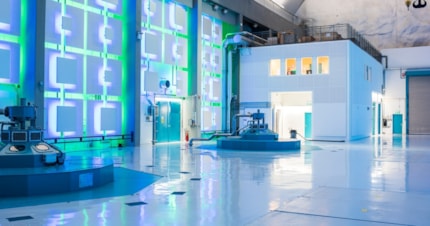Description: The primary objective is secure reliable operation and lifetime for high head Francis turbines operating in the future energy market.
Secondary objectives: Determine how water parameters such as vapor and gas content influences the pressure propagation speed and the damping of pressure oscillation in high head Francis turbine components such as a guide vane cascade and in a Francis model turbine
2. Determine how the water parameters and velocity field impacts the dynamic coupling between fluid and structure for a high head Francis turbine. This includes impact of the water on the natural frequency but may also include new coupled modes as well as change in the modal response.
3. Evaluation of fatigue loads of a high head Francis turbine during steady state and transient operation
4. Ensure that the project outcome is in line with the industry's best interestand optimize the industrial value through innovative usage of the project results.
Background: HiFrancis was born out of the need for further knowledge regarding a series of Francis turbine failures in the national grid. In the current market, turbines are operating at off-design operational conditions, and the industry is facing problems with both newly installed and old Francis units. The main problem is crack formation in the turbine runner, caused by pressure fluctuations.
Method: The project will work with simplified models for the turbine runner and a complete Francis turbine model, and thorough measurements combined with FSI-analysis will be carried out. The flow conditions in a Francis turbine runner will be simplified and isolated in a blade cascade and the material properties such as the natural frequency of the runner will be tested with simplified geometry. The model of the Francis turbines at Tokke power plant will be utilized for the measurements. Here, steady state and transient operation of the turbine will be investigated. The main challenge is to carry out good measurements of the pressure and stress in the runner. The measurements from the Tokke model turbine will be provided to other researchers through the Francis-99 workshops. The Francis-99 workshops aim to determine the state of the art of high head Francis turbine simulations (flow and structure) under steady and transient operating conditions as well as promote their development and knowledge dissemination openly. The project also includes a component on Computational Fluid Dynamics to improve the computational methods.
Work schedule : The project will last for four years from 2016 to 2020. Executing partners are NTNU and EDR medeso. Ph.D - students are engaged and seminars are arranged during the project period.
Budget and financing : A total budget of 26 million - 6.5 million NOK per year. The cost will be shared ~50% Norwegian Research Council and 50% industry.
Prosject responsible – NTNU/HydroCen (own funds) represented by: Bjørn Winther Solemslie


